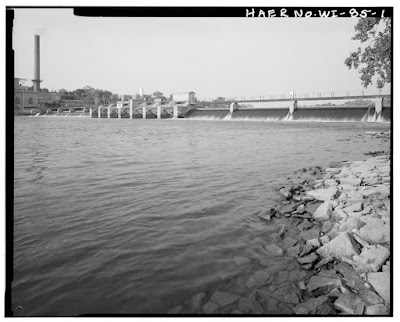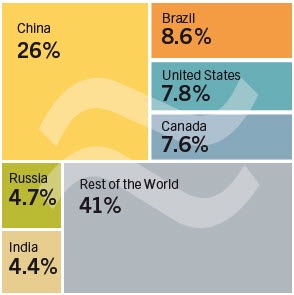Harnessing the power of water isn't a new concept. As early as two thousand years ago, the Ancient Greeks were using water as a source of energy. The earliest utilisation of this energy was to grind flour, but by the mid-1800s a French Engineer, Benoit Fourneyron, had produced a highly efficient turbine; the design was then improved upon and in a short period, numerous factories used this turbine style. By 1800, water power from the Grand Rapids in Michigan was being used to provide electricity to a local theatre and store and two years later, the first hydro-electricity plant opened in Wisconsin.
Today, hydropower is the most widely used renewable resource, representing 6.8% of the world's primary energy consumption. In 2013, China, Brazil, the US, Canada, Russia, India and Norway accounted for over 62% of installed global hydropower capacity. Globally, the largest dam for installed capacity is the Three Gorges Dam spanning the Yangtze River in China and closely followed by the Itaipu Dam bordering Brazil and Paraguay and the Xiluodo Dam, situated on the Jinsha River which was completed in 2014.
 |
| The world's first Hydro-Electricity Plant at Appleton, Wisconsin Source: National Geographic |
 |
| Shares of Top 6 Countries for Global Hydropower Capacity Source: REN 21 |
To create hydropower, the kinetic energy of moving water must be utilised. The diagram below shows the movement of water through a Reservoir Hydropower Plant. By opening the gates, gravity forces the water down the Penstock as shown below, which rotates the turbine as it moves through. This turbine is attached to the generator which produces the electricity for transportation via power lines to homes and businesses.
 |
| Reservoir Hydropower Plant Source: Tennessee Valley Authority |
In addition to the Reservoir Hydropower Plant outlined above, there are two other ways in which hydropower is created; Run-of-the-River and the Pumped Storage methods. All three are outlined below:
1. Run-of-the-River
Run-of-the-River plants generate energy on a smaller scale, usually diverting part of the river and using its natural flow to rotate the turbines before returning it downstream. It is a low-impact way of producing hydropower without the need to create large dams but due to the lack of reservoir, energy is reliant on the flow of water at that time, therefore energy generation cannot suddenly increase to meet demand.
2. Pumped Storage
During periods of high energy demand, water flows from the upper reservoir into the lower reservoir, rotating the turbine as it travels. However, unlike the second example, during periods of low energy demand, the upper reservoir is recharged through pumping water from the lower reservoir. Due to the storage of water, demand can quickly be met by the release of water, despite this, once the upper reservoir has been used, it must be recharged for energy generation to continue; additional energy must be used to complete this action.
3. Reservoir (Storage)
As shown in the diagram above, reservoir hydropower plants require the creation of a dam to collect the water which can then be released from the gates in order to produce energy. Water is conserved as potential energy within the reservoir which can be converted to electricity as and when there is demand. Nevertheless, there are numerous environmental and social impacts of dam construction including destruction of natural habitats and relocation of towns and villages; I will go into these issue in more detail in my next blog.
Although reservoir hydropower is the most widespread, smaller scale run-of-the-river projects are becoming more common, with proposals set for a number of Himalayan rivers. Overall, global hydropower capacity is increasing and 2014 saw a 2% rise in global output with 19 new hydroelectric plants under construction. Hydropower has even greater potential in future because not only has the technology and infrastructure developed significantly to allow for huge quantities of electricity to be produced, but dams can also meet urgent energy demand, something that is critical for nations intending to replace fossil fuels with renewables.
I certainly expect hydropower to become more heavily relied upon as nations strive to meet energy demand through sustainable means.
No comments:
Post a Comment